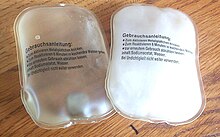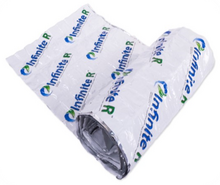相变材料

相变材料(英語:phase change material,缩写为:PCM)是指在相变时放出或吸收大量热,以达到加热或降温作用的物质。通常情况下,该物质将在液态和固态间进行转变,但也可以在非传统状态间进行转变,例如从一种结晶态转变为能量更高或更低的另一种结晶态。
相变材料物质状态改变时所需的熔化热通常远大于其显热,相变温度(PCT)附近融化和凝固时,相变材料可以储存和释放巨大的能量。例如,冰融化成水的熔化热为333.55 J/g,即一克冰需要吸收333.55 J热量才能融化成水。然而一克水吸收4.18 J热量温度升高1度。因此水/冰是一种非常有用的相变材料,自阿契美尼德王朝开始人们就用它在冬天释放热量,在夏天给房子降温。
相变材料可按组成物质种类进行分类。有机相变材料通常从石油、植物或动物上提取,水合盐相变材料通常由海水或矿物中提取。还有一类是固体转变为固体的相变材料。他们在生活中有着广泛的应用,加热垫、电话配电箱冷却和服饰制造等都可以看到相变材料的身影。
特性和分类
[编辑]液体→固体、固体→液体、固体→气体和液体→气体的变化过程均可储存潜热,但只有液体→固体和固体→液体变化过程较为现实。尽管液体→气体过程中转换的热量更多,但是气态体积较大,存储需要高压,不易于使用。固态→固态的转变速度十分缓慢,转换的热量相对较少。
固态-液态相变材料在达到相变温度前,其特性与显热储存材料相似,吸收热量的同时温度逐渐上升。但是当到达相变温度(熔点)时,开始大量吸收热量,但是温度保持不变,材料完全融化后,温度继续上升。当液态材料所处环境温度下降时便开始凝固,释放其所储存的潜热。各种相变材料可供选择,−5到190 °C之间任意相变温度均有对应。[1]而在20-30 °C人体舒适温度范围内,有些材料潜热吸收十分高效,可以达到200 kJ/kg,与之对应的石料的热容一般为1 kJ/kg.°C,因此保持相同温度时每千克材料吸收的热量是石料的200倍。[2]水的比热容为4.21 kJ/kg.°C,该材料存储密度为水的12.5倍至50倍之间。
有机相变材料
[编辑]碳氢化合物,主要是石蜡(CnH2n+2)和脂质类物质,也有一种是糖醇。[3][4][5]
- 优点
- 凝固时没有过冷效应
- 能够一致地融化
- 自成核性质
- 与常规结构材料相容性好
- 没有隔离
- 化学性质稳定
- 安全、无反应
- 缺点
非有机相变材料
[编辑]水合盐 (MxNyH2O) [8]
- 优点
- 体积潜热储存容量高
- 易于获取,成本低
- 高熔点
- 热传导率高
- 熔化热高
- 不可燃
- 缺点

应用
[编辑]

- 储热
- 太阳能锅
- 冷能电池
- 建筑温控
- 发动机和电机降温
- 制冷:食物、饮料、咖啡、葡萄酒、奶制品、温室
- 延缓表面凝霜[16]
- 医疗器械:血液运输、操作台、热治疗、新生儿窒息治疗[14]
- 笨重的衣服或服装下的人体冷却.
- 废热回收
- 错峰电力利用:加热、冷却水
- 熱泵系统
- 被动存储綠色建築(HDPE、石蜡)
- 缓和化学反应放热过程中的温度峰值
- 太陽能發電站
- 航天器温控系统
- 车辆熱舒適性
- 电子仪器溫度保險絲
- 服装用纺织品
- 电脑硬件冷却
- 带有热能储存功能的的涡轮机入风口冷却
- 热带地区的电信设备保护
参见
[编辑]- Raoux, S. Phase Change Materials. Annual Review of Materials Research. 2009, 39: 25–48. Bibcode:2009AnRMS..39...25R. doi:10.1146/annurev-matsci-082908-145405.
- Phase Change Matters (页面存档备份,存于互联网档案馆) (industry blog)
参考资料
[编辑]- ^ 1.0 1.1 Kenisarin, M; Mahkamov, K. Solar energy storage using phase change materials. Renewable and Sustainable –1965. 2007, 11 (9): 1913–1965. doi:10.1016/j.rser.2006.05.005.
- ^ Sharma, Atul; Tyagi, V.V.; Chen, C.R.; Buddhi, D. Review on thermal energy storage with phase change materials and applications. Renewable and Sustainable Energy Reviews. 2009, 13 (2): 318–345. doi:10.1016/j.rser.2007.10.005.
- ^ "Heat storage systems" (页面存档备份,存于互联网档案馆) (PDF) by Mary Anne White, brings a list of advantages and disadvantages of Paraffin heat storage. A more complete list can be found in AccessScience (页面存档备份,存于互联网档案馆) website from McGraw-Hill, DOI 10.1036/1097-8542.YB020415, last modified: March 25, 2002 based on 'Latent heat storage in concrete II, Solar Energy Materials, Hawes DW, Banu D, Feldman D, 1990, 21, pp.61–80.
- ^ Floros, Michael C.; Kaller, Kayden L. C.; Poopalam, Kosheela D.; Narine, Suresh S. Lipid derived diamide phase change materials for high temperature thermal energy storage. Solar Energy. 2016-12-01, 139: 23–28. Bibcode:2016SoEn..139...23F. doi:10.1016/j.solener.2016.09.032.
- ^ Agyenim, Francis; Eames, Philip; Smyth, Mervyn. Experimental study on the melting and solidification behaviour of a medium temperature phase change storage material (Erythritol) system augmented with fins to power a LiBr/H2O absorption cooling system. Renewable Energy. 2011-01-01, 36 (1): 108–117. doi:10.1016/j.renene.2010.06.005.
- ^ Fleishcher, A.S. Improved heat recovery from paraffn-based phase change materials due to the presence of percolating graphene networks. Improved Heat Recovery from Paraffn-based Phase Change Materials Due to the Presence of Percolating Graphene Networks. 2014, 79: 324–333.
- ^ (2015). Thermal energy storage using phase change materials: fundamentals and applications. Springer
- ^ Phase Change Energy Solutions https://id.elsevier.com/as/authorization.oauth2?platSite=SD%2Fscience&scope=openid+email+profile+els_auth_info+urn%3Acom%3Aelsevier%3Aidp%3Apolicy%3Aproduct%3Ainst_assoc&response_type=code&redirect_uri=https%3A%2F%2Fwww.sciencedirect.com%2Fuser%2Fidentity%2Flanding&authType=SINGLE_SIGN_IN&prompt=none&client_id=SDFE-v3&state=retryCounter%3D0%26csrfToken%3D7b73d88c-a46a-4ce5-8a58-7a21b367a560%26idpPolicy%3Durn%253Acom%253Aelsevier%253Aidp%253Apolicy%253Aproduct%253Ainst_assoc%26returnUrl%3Dhttps%253A%252F%252Fwww.sciencedirect.com%252Ftopics%252Fengineering%252Fsalt-hydrate%26prompt%3Dnone%26cid%3Dtpp-9ec8e252-5eaf-44ce-a8d4-838d9800b9b3. [February 28, 2018]. 缺少或
|title=为空 (帮助) - ^ Cantor, S. DSC study of melting and solidification of salt hydrates. Thermochimica Acta. 1978, 26 (1–3): 39–47 [2020-06-27]. doi:10.1016/0040-6031(78)80055-0. (原始内容存档于2021-03-11).
- ^ olé, A.; Miró, L.; Barreneche, C.; Martorell, I.; Cabeza, L.F. Corrosion of metals and salt hydrates used for thermochemical energy storage. Renewable Energy. 2015, 75: 519–523. doi:10.1016/j.renene.2014.09.059.[失效連結]
- ^ A. Sharma; V. Tyagi; C. Chen; D. Buddhi. Review on thermal energy storage with phase change materials and applications. Renewable and Sustainable Energy Reviews. February 2009, 13 (2): 318–345. doi:10.1016/j.rser.2007.10.005.
- ^ Sharma, Someshower Dutt; Kitano, Hiroaki; Sagara, Kazunobu. Phase Change Materials for Low Temperature Solar Thermal Applications (PDF). Res. Rep. Fac. Eng. Mie Univ. 2004, 29: 31–64 [2020-06-27]. (原始内容存档 (PDF)于2020-06-27).
- ^ Infinite R™. Insolcorp, Inc. [2017-03-01]. (原始内容存档于2020-12-02).
- ^ 14.0 14.1 Aravind, Indulekha; Kumar, KP Narayana. How two low-cost, made-in-India innovations MiraCradle & Embrace Nest are helping save the lives of newborns. timesofindia-economictimes. 2015-08-02 [2020-06-27]. (原始内容存档于2020-08-20).
- ^ MiraCradle - Neonate Cooler. [2022-01-19]. (原始内容存档于2021-03-11).
- ^ 16.0 16.1 Chatterjee, Rukmava; Beysens, Daniel; Anand, Sushant. Delaying Ice and Frost Formation Using Phase-Switching Liquids. Advanced Materials. 2019, 0 (17): 1807812. ISSN 1521-4095. PMID 30873685. doi:10.1002/adma.201807812
 (英语).
(英语).
- ^ Omer, A. Renewable building energy systems and passive human comfort solutions. Renewable and Sustainable Energy Reviews. 2008, 12 (6): 1562–1587. doi:10.1016/j.rser.2006.07.010.
来源
[编辑]- PHASE CHANGE MATERIAL (PCM) BASED ENERGY STORAGE MATERIALS AND GLOBAL APPLICATION EXAMPLES
Zafer URE M.Sc., C.Eng. MASHRAE HVAC Applications (页面存档备份,存于互联网档案馆)
- Phase Change Material Based Passive Cooling Systems Design Principal and Global Application Examples
Zafer URE M.Sc., C.Eng. MASHRAE Passive Cooling Application (页面存档备份,存于互联网档案馆)
Text is available under the CC BY-SA 4.0 license; additional terms may apply.
Images, videos and audio are available under their respective licenses.
